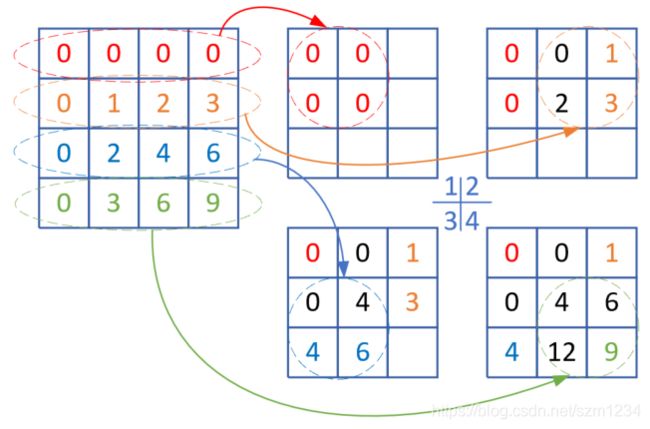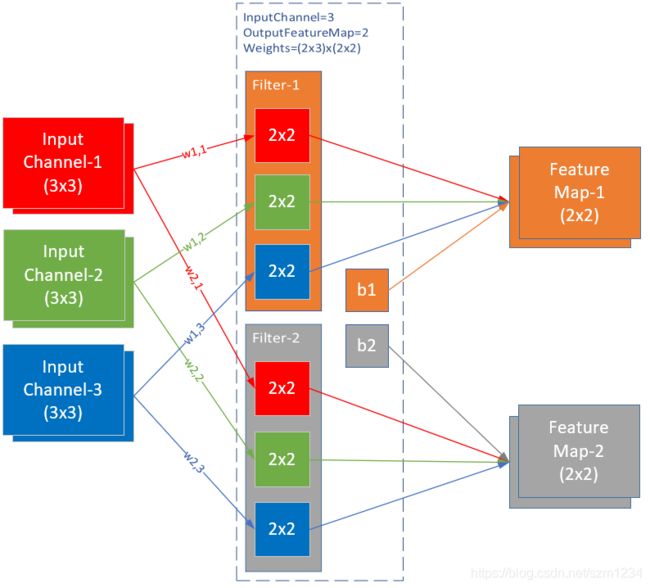CNN | 04卷积反向传播代码实现
4 卷积反向传播代码实现
4.1 方法1
完全按照17.3中的讲解来实现反向传播,但是由于有17.2中关于numba帮助,我们在实现代码时,可以考虑把一些模块化的计算放到独立的函数中,用numba在运行时编译加速。
def backward_numba(self, delta_in, flag):
# 如果正向计算中的stride不是1,转换成是1的等价误差数组
dz_stride_1 = expand_delta_map(delta_in, ...)
# 计算本层的权重矩阵的梯度
self._calculate_weightsbias_grad(dz_stride_1)
# 由于输出误差矩阵的尺寸必须与本层的输入数据的尺寸一致,所以必须根据卷积核的尺寸,调整本层的输入误差矩阵的尺寸
(pad_h, pad_w) = calculate_padding_size(...)
dz_padded = np.pad(dz_stride_1, ...)
# 计算本层输出到下一层的误差矩阵
delta_out = self._calculate_delta_out(dz_padded, flag)
#return delta_out
return delta_out, self.WB.dW, self.WB.dB
# 用输入数据乘以回传入的误差矩阵,得到卷积核的梯度矩阵
def _calculate_weightsbias_grad(self, dz):
self.WB.ClearGrads()
# 先把输入矩阵扩大,周边加0
(pad_h, pad_w) = calculate_padding_size(...)
input_padded = np.pad(self.x, ...)
# 输入矩阵与误差矩阵卷积得到权重梯度矩阵
(self.WB.dW, self.WB.dB) = calcalate_weights_grad(...)
self.WB.MeanGrads(self.batch_size)
# 用输入误差矩阵乘以(旋转180度后的)卷积核
def _calculate_delta_out(self, dz, layer_idx):
if layer_idx == 0:
return None
# 旋转卷积核180度
rot_weights = self.WB.Rotate180()
# 定义输出矩阵形状
delta_out = np.zeros(self.x.shape)
# 输入梯度矩阵卷积旋转后的卷积核,得到输出梯度矩阵
delta_out = calculate_delta_out(dz, ..., delta_out)
return delta_out
为了节省篇幅,上面的代码中做了一些省略,只保留了基本的实现思路,并给出了详尽的注释,相信读者在充分理解17.3的内容的基础上,可以看懂。
其中,两个计算量大的函数,一个是计算权重矩阵的基础函数calcalate_weights_grad,另一个是计算输出误差矩阵的基础函数calculate_delta_out,都使用了numba的方式实现,以加快反向传播代码的运行速度。
4.2 方法2
在前向计算中,我们试验了img2col的方法,取得了不错的效果。在反向传播中,也有对应的逆向方法,叫做col2img。下面我们基于它来实现另外一种反向传播算法,其基本思想是:把反向传播也看作是全连接层的方式,直接用矩阵运算代替卷积操作,然后把结果矩阵再转换成卷积操作的反向传播所需要的形状。
代码实现
def backward_col2img(self, delta_in, layer_idx):
OutC, InC, FH, FW = self.WB.W.shape
# 误差矩阵变换
delta_in_2d = np.transpose(delta_in, axes=(0,2,3,1)).reshape(-1, OutC)
# 计算Bias的梯度
self.WB.dB = np.sum(delta_in_2d, axis=0, keepdims=True).T / self.batch_size
# 计算Weights的梯度
dW = np.dot(self.col_x.T, delta_in_2d) / self.batch_size
# 转换成卷积核的原始形状
self.WB.dW = np.transpose(dW, axes=(1, 0)).reshape(OutC, InC, FH, FW)# 计算反向传播误差矩阵
dcol = np.dot(delta_in_2d, self.col_w.T)
# 转换成与输入数据x相同的形状
delta_out = col2img(dcol, self.x.shape, FH, FW, self.stride, self.padding)
return delta_out, self.WB.dW, self.WB.dB
单样本单通道的实例讲解
假设有1个样本1个通道且图片为3x3的矩阵:
x=
[[[[0 1 2]
[3 4 5]
[6 7 8]]]]
col_x=
[[0. 1. 3. 4.]
[1. 2. 4. 5.]
[3. 4. 6. 7.]
[4. 5. 7. 8.]]
卷积核也只有1个形状为1x1x2x2的矩阵:
w=
[[[[0 1]
[2 3]]]]
卷积核展开后:
col_w=
[[0]
[1]
[2]
[3]]
卷积的结果会是一个样本在一个通道上的2x2的输出。
再假设从后端反向传播回来的输入误差矩阵:
delta_in=
[[[[0 1]
[2 3]]]]
误差矩阵经过下式变换:
delta_in_2d = np.transpose(delta_in, axes=(0,2,3,1)).reshape(-1, OutC)
得到:
delta_in_2d=
[[0]
[1]
[2]
[3]]
计算dB(这一步和全连接层完全相同):
self.WB.dB = np.sum(delta_in_2d, axis=0, keepdims=True).T / self.batch_size
得到:
dB=
[[6.]]
计算dW(这一步和全连接层完全相同):
dW = np.dot(self.col_x.T, delta_in_2d) / self.batch_size
得到:
dW=
[[19.]
[25.]
[37.]
[43.]]
还原dW到1x1x2x2的卷积核形状:
self.WB.dW = np.transpose(dW, axes=(1, 0)).reshape(OutC, InC, FH, FW)
得到:
dW=
[[[[19. 25.]
[37. 43.]]]]
至此,dB和dW都已经得到,本层的梯度计算完毕,需要把梯度回传给前一层,所以要计算输出误差矩阵(这一步和全连接层完全相同):
dcol = np.dot(delta_in_2d, self.col_w.T)
得到:
dcol=
[[0 0 0 0]
[0 1 2 3]
[0 2 4 6]
[0 3 6 9]]
转换成正确的矩阵形状:
delta_out = col2img(dcol, self.x.shape, FH, FW, self.stride, self.padding)
得到:
delta_out=
[[[[ 0. 0. 1.]
[ 0. 4. 6.]
[ 4. 12. 9.]]]]
下面我们解释一下最后一步的运算过程,如图17-30所示。
图17-30 col2img图解
得到上述dcol的4x4矩阵后,我们要把它逆变换到一个3x3的矩阵中,步骤如下:
- 左侧第一行红色椭圆内的四个元素移到右侧红色圆形内;
- 在1的基础上,左侧第二行黄色椭圆内的四个元素移到右侧黄色圆形内,其中与原有元素重叠的地方则两个值相加。比如中间那个元素就是0+2=2;
- 在2的基础上,左侧第三行蓝色椭圆内的四个元素移到右侧蓝色圆形内,其中与原有元素重叠的地方则两个值相加。比如中间那个元素再次加2;
- 在3的基础上,左侧第四行绿色椭圆内的四个元素移到右侧绿色圆形内,其中与原有元素重叠的地方则两个值相加,中间的元素再次加0,还是4;中间靠下的元素原值是6,加6后为12。
这个结果和最后一步delta_out的结果完全一致。
多样本多通道的实例讲解
图17-31是两个样本的例子,输入通道为3,输出通道为2。
图17-31 两个样本三通道两个卷积核的例子
图17-31中的各组件参数如下:
- batch size = 2
- input channel = 3
- input height = 3
- input width = 3
- filter height = 2
- filter width = 2
- stride = 1
- padding = 0
- output channel = 2
- output height = 2
- output width = 2
误差输入矩阵
delta_in是本层的误差输入矩阵,它的形状应该和本层的前向计算结果一样。在本例中,误差输入矩阵的形状应该是:(batch_size * output_channel * output_height * output_width) = (2 x 2 x 2 x 2):
delta_in=
(样本1)
(通道1)
[[[[ 0 1]
[ 2 3]]
(通道2)
[[ 4 5]
[ 6 7]]]
(样本2)
(通道1)
[[[ 8 9]
[10 11]]
(通道2)
[[12 13]
[14 15]]]]
为了做img2col的逆运算col2img,我们把它转换成17.2中的结果数据的形状8x2:
delta_in_2d = np.transpose(delta_in, axes=(0,2,3,1)).reshape(-1, OutC)
delta_in_2d=
[[ 0 4]
[ 1 5]
[ 2 6]
[ 3 7]
[ 8 12]
[ 9 13]
[10 14]
[11 15]]
计算权重矩阵的梯度:
dW = np.dot(self.col_x.T, delta_in_2d) / self.batch_size
结果:
dW=
[[ 564.| 812.]
[ 586.| 850.]
[ 630.| 926.]
[ 652.| 964.]
------+-------
[ 762.| 1154.]
[ 784.| 1192.]
[ 828.| 1268.]
[ 850.| 1306.]
------+-------
[ 960.| 1496.]
[ 982.| 1534.]
[1026.| 1610.]
[1048.| 1648.]]
但是这个12x2的结果是对应的权重矩阵的二维数组展开形式的,所以要还原成原始的卷积核形式2x3x2x2:
self.WB.dW = np.transpose(dW, axes=(1, 0)).reshape(OutC, InC, FH, FW)
结果:
dW=
(过滤器1) (过滤器2)
(卷积核1) (卷积核1)
[[[[ 564. 586.] [[[ 812. 850.]
[ 630. 652.]] [ 926. 964.]]
(卷积核2) (卷积核2)
[[ 762. 784.] [[1154. 1192.]
[ 828. 850.]] [1268. 1306.]]
(卷积核3) (卷积核3)
[[ 960. 982.] [[1496. 1534.]
[1026. 1048.]]] [1610. 1648.]]]]
计算误差输出矩阵:
dcol = np.dot(delta_in_2d, self.col_w.T)
得到:
dcol=
[[ 48 52 56 60 64 68 72 76 80 84 88 92]
[ 60 66 72 78 84 90 96 102 108 114 120 126]
[ 72 80 88 96 104 112 120 128 136 144 152 160]
[ 84 94 104 114 124 134 144 154 164 174 184 194]
[144 164 184 204 224 244 264 284 304 324 344 364]
[156 178 200 222 244 266 288 310 332 354 376 398]
[168 192 216 240 264 288 312 336 360 384 408 432]
[180 206 232 258 284 310 336 362 388 414 440 466]]
但是dcol对应的是输入数据的二维展开形式4x12,应该把它还原成2x3x3x3的形式:
delta_out = col2img(dcol, self.x.shape, FH, FW, self.stride, self.padding)
得到:
delta_out=
(样本1) (样本2)
(通道1) (通道1)
[[[[ 48. 112. 66.] [[[ 144. 320. 178.]
[ 128. 296. 172.] [ 352. 776. 428.]
[ 88. 200. 114.]] [ 216. 472. 258.]]
(通道2) (通道2)
[[ 64. 152. 90.] [[ 224. 488. 266.]
[ 176. 408. 236.] [ 528. 1144. 620.]
[ 120. 272. 154.]] [ 312. 672. 362.]]
(通道3) (通道3)
[[ 80. 192. 114.] [[ 304. 656. 354.]
[ 224. 520. 300.] [ 704. 1512. 812.]
[ 152. 344. 194.]]] [ 408. 872. 466.]]]]
4.3 正确性与性能测试
在正向计算中,numba稍胜一筹,下面我们来测试一下二者的反向计算性能,然后比较梯度输出矩阵的结果来验证正确性。
def test_performance():
...
先用numba方法测试1000次的正向+反向,然后再测试1000次img2col的正向+反向,同时我们会比较反向传播的三个输出值:误差矩阵b、权重矩阵梯度dw、偏移矩阵梯度db。
输出结果:
method numba: 11.830008506774902
method img2col: 3.543151378631592
compare correctness of method 1 and method 2:
forward: True
backward: True
dW: True
dB: True
这次img2col方法完胜,100次的正向+反向用了3.5秒,而numba方法花费的时间是前者的三倍多。再看二者的前向计算和反向传播的结果比较,四个矩阵的比较全都是True,说明我们的代码是没有问题的。
那么我们能不能混用numba方法的前向计算和img2col方法的反向传播呢?不行。因为img2col方法的反向传播需要用到其正向计算方法中的两个缓存数组,一个是输入数据的矩阵变换结果,另一个是权重矩阵变换结果,所以img2col方法必须正向反向配合使用。
代码位置
ch17, Level4
Level4_Col2Img_Test.py中有两个方法:
- understand_4d_col2img_simple - 用单样本单通道理解反向传播
- understand_4d_col2img_complex - 用多样本多通道理解反向传播
Level4_BackwardTest.py用来测试两种方法的性能。

